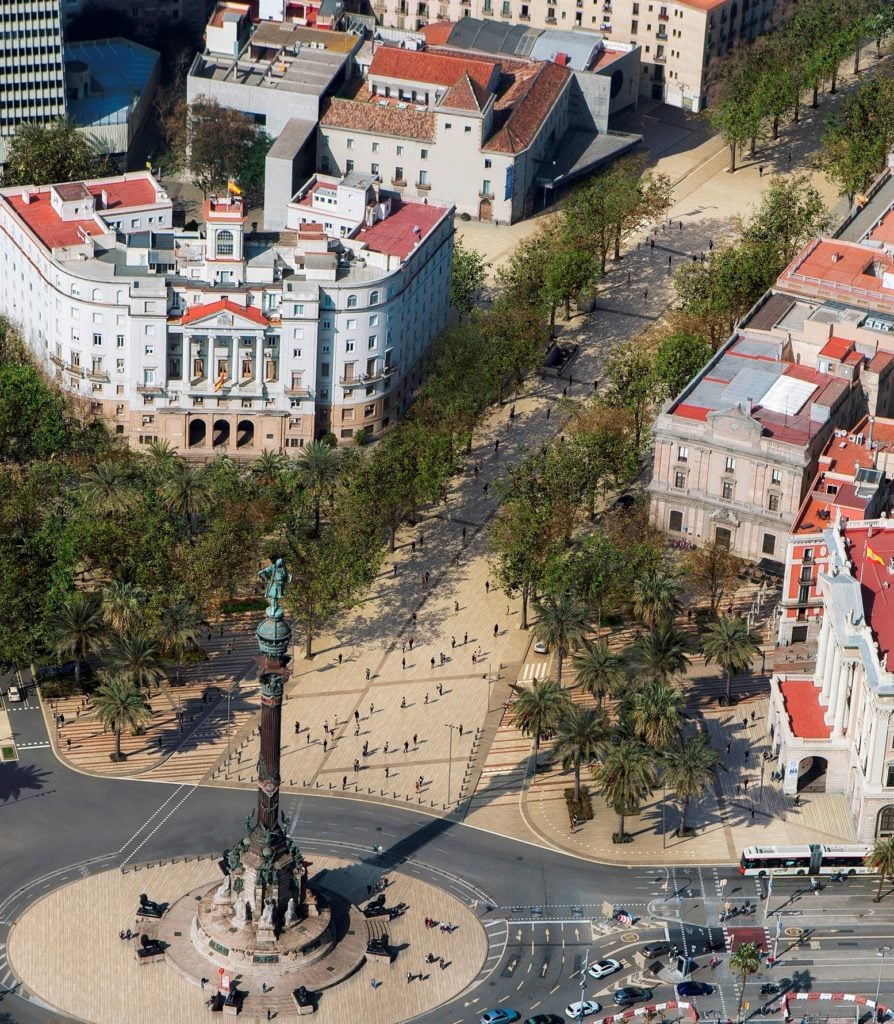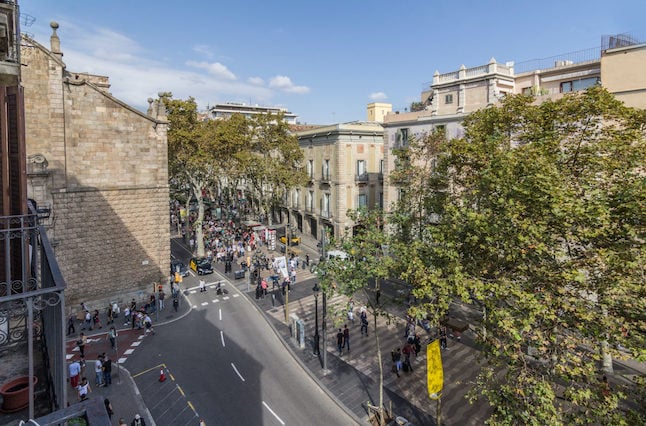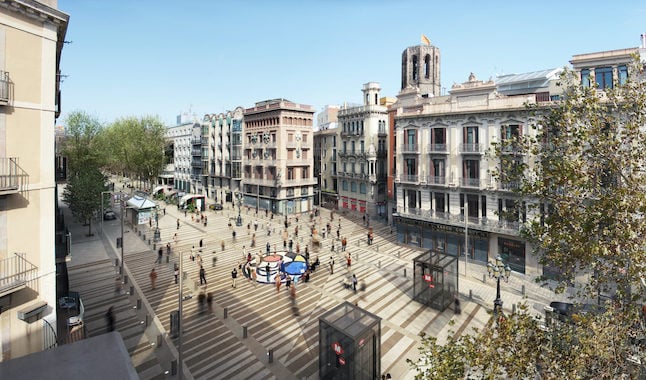IN PICS: How Barcelona's La Rambla is set to be transformed

Authorities in the Catalan capital have started to redevelop Barcelona's most iconic street, not only transforming how it looks, but also the way it's used. Here's what it will be like and what you should know about the project.
More than 200,000 people walk along La Rambla de Barcelona (also called Las Ramblas) every day, adding up to around 80 million people a year.
It's by far the most famous street in Barcelona - perhaps even Spain together with Madrid's Gran Vía - although nowadays it's particularly popular with tourists visiting the city.
It's lively, some would say chaotic, and in recent years pickpocketing and other illicit acts have tarnished its image.
Now city authorities have embarked on an ambitious plan to transform Las Ramblas, providing more room for pedestrians and giving residents the chance to reclaim the space for their own enjoyment.
The plan to transform Barcelona’s emblematic Las Ramblas Street was first proposed back in 2017, but it wasn’t until last week that Catalonia’s Urban Planning Commission gave its final approval and the go-ahead for works to begin on Monday October 3rd.
The redevelopment has a total budget of €44.56 million and will be carried out in stages, with the first one expected to last 18 months.
The aim of the project is to modernise Las Ramblas, whilst at the same time, enhancing its historic elements and reactivating local commerce, as well as creating more space for pedestrians.

The bottom of La Rambla near the port will be the first part to be transformed. Photo: Ajuntament de Barcelona
The new layout of the Rambla will improve the accessibility and connectivity between the Raval and Gòtico neighbourhoods.
 La Rambla will become a greener space. Photo: Ajuntament de Barcelona
Barcelona City Council also wants to make it a greener and nicer space for locals to use, as well as turning it into a cultural hub rather than just somewhere for tourists.
New seating areas will be created under the trees along the route to ensure a balanced use of the public space between areas for leisure and areas where locals live.
The press kiosks will also be relocated and redistributed so that they do not face each other. Instead, they will be scattered between the trees along the Rambla de les Flors-Sant Josep, where they have historically been located.
La Rambla will become a greener space. Photo: Ajuntament de Barcelona
Barcelona City Council also wants to make it a greener and nicer space for locals to use, as well as turning it into a cultural hub rather than just somewhere for tourists.
New seating areas will be created under the trees along the route to ensure a balanced use of the public space between areas for leisure and areas where locals live.
The press kiosks will also be relocated and redistributed so that they do not face each other. Instead, they will be scattered between the trees along the Rambla de les Flors-Sant Josep, where they have historically been located.
 The way the pavements and roads look currently. Photo: Ajuntament de Barcelona
The pavement will be one of the main elements of transformation. In essence, city workers will reduce the amount of space allocated to vehicles and will give more of it to pedestrians.
There will now be one lane for vehicles rather than the current two, with sidewalks of at least 3 metres on either side.
Currently, the pavements on the sides of La Rambla are very slim and only allow for people to walk in single file, with others having to step onto the road to let people pass.
The way the pavements and roads look currently. Photo: Ajuntament de Barcelona
The pavement will be one of the main elements of transformation. In essence, city workers will reduce the amount of space allocated to vehicles and will give more of it to pedestrians.
There will now be one lane for vehicles rather than the current two, with sidewalks of at least 3 metres on either side.
Currently, the pavements on the sides of La Rambla are very slim and only allow for people to walk in single file, with others having to step onto the road to let people pass.
 A bird's eye view of how the new Rambla will look. Photo: Ajuntament de Barcelona
The road will be restricted to neighbourhood traffic (residents' vehicles), bicycles as well as service vehicles such as buses, taxis, delivery trucks and ambulances.
A bird's eye view of how the new Rambla will look. Photo: Ajuntament de Barcelona
The road will be restricted to neighbourhood traffic (residents' vehicles), bicycles as well as service vehicles such as buses, taxis, delivery trucks and ambulances.
 The central section of La Rambla will be widened. Photo: Ajuntament de Barcelona
The central promenade will also be widened, creating more space for both pedestrians and trees. It will be created from types of natural stone, granite and porphyry (a red stone embedded with quartz). This will allow for a simpler and more functional design.
There will no longer be any tarmac for vehicles either, the whole of Las Ramblas will be paved without a curb separating the road from the promenade.
In light of the terrorist attack on La Rambla in 2017, more security elements such as bollards and blockades will be incorporated.
The central section of La Rambla will be widened. Photo: Ajuntament de Barcelona
The central promenade will also be widened, creating more space for both pedestrians and trees. It will be created from types of natural stone, granite and porphyry (a red stone embedded with quartz). This will allow for a simpler and more functional design.
There will no longer be any tarmac for vehicles either, the whole of Las Ramblas will be paved without a curb separating the road from the promenade.
In light of the terrorist attack on La Rambla in 2017, more security elements such as bollards and blockades will be incorporated.
 One of the new centres of La Rambla near the Liceu Theatre. Photo: Ajuntament de Barcelona
The plan is to create three large spaces, almost like plazas, including one near the Betlem church, one near the Boqueria market and one near the Liceu Theater. These will be configured differently and have a more circular flow, instead of just a longitudinal one, allowing for more cultural elements too.
The city council has already started creating more cultural events around Las Ramblas with the introduction of the Àgora Musical de la Plaça Reial festival, which has attracted more than 7500 people attending 50 concerts, held between June and October this year.
One of the new centres of La Rambla near the Liceu Theatre. Photo: Ajuntament de Barcelona
The plan is to create three large spaces, almost like plazas, including one near the Betlem church, one near the Boqueria market and one near the Liceu Theater. These will be configured differently and have a more circular flow, instead of just a longitudinal one, allowing for more cultural elements too.
The city council has already started creating more cultural events around Las Ramblas with the introduction of the Àgora Musical de la Plaça Reial festival, which has attracted more than 7500 people attending 50 concerts, held between June and October this year.
Comments
See Also
More than 200,000 people walk along La Rambla de Barcelona (also called Las Ramblas) every day, adding up to around 80 million people a year.
It's by far the most famous street in Barcelona - perhaps even Spain together with Madrid's Gran Vía - although nowadays it's particularly popular with tourists visiting the city.
It's lively, some would say chaotic, and in recent years pickpocketing and other illicit acts have tarnished its image.
Now city authorities have embarked on an ambitious plan to transform Las Ramblas, providing more room for pedestrians and giving residents the chance to reclaim the space for their own enjoyment.
The plan to transform Barcelona’s emblematic Las Ramblas Street was first proposed back in 2017, but it wasn’t until last week that Catalonia’s Urban Planning Commission gave its final approval and the go-ahead for works to begin on Monday October 3rd.
The redevelopment has a total budget of €44.56 million and will be carried out in stages, with the first one expected to last 18 months.
The aim of the project is to modernise Las Ramblas, whilst at the same time, enhancing its historic elements and reactivating local commerce, as well as creating more space for pedestrians.






Join the conversation in our comments section below. Share your own views and experience and if you have a question or suggestion for our journalists then email us at [email protected].
Please keep comments civil, constructive and on topic – and make sure to read our terms of use before getting involved.
Please log in here to leave a comment.